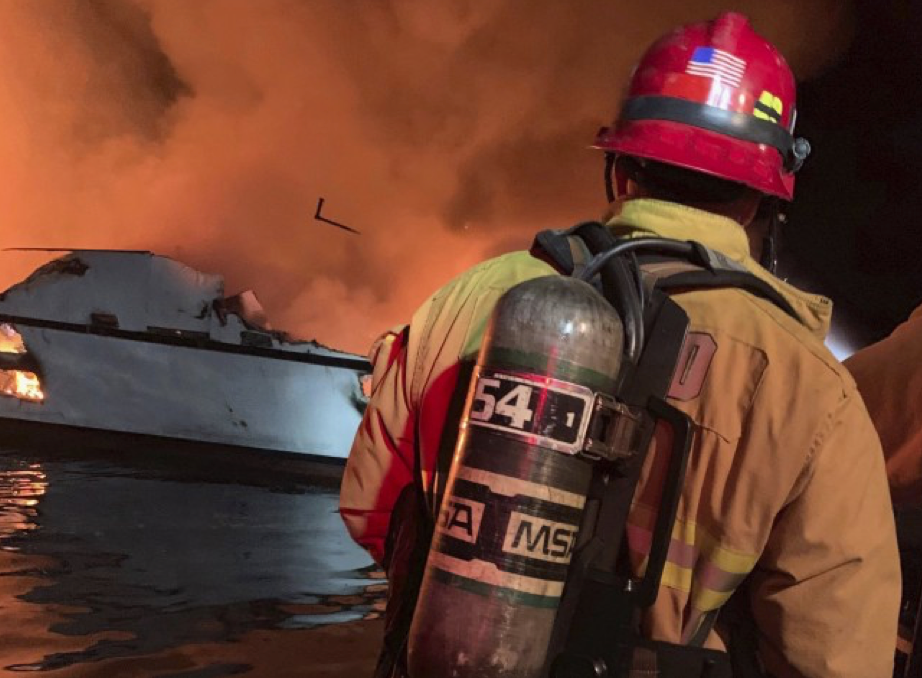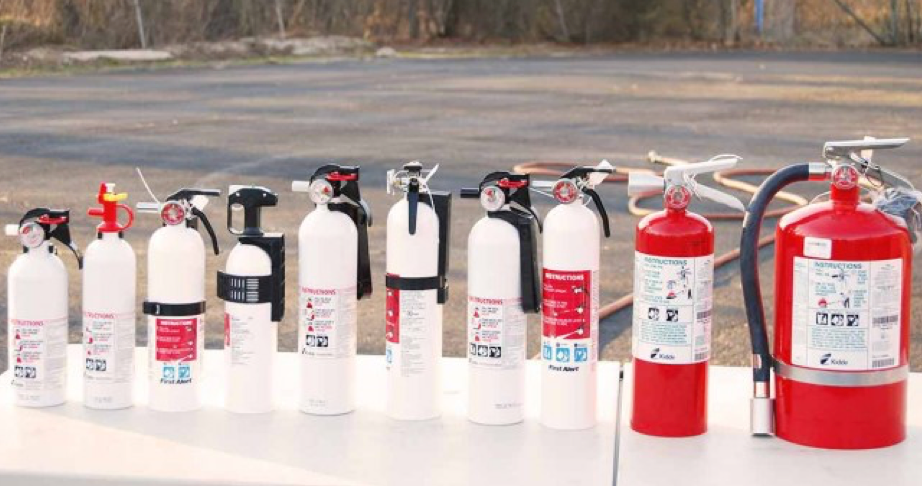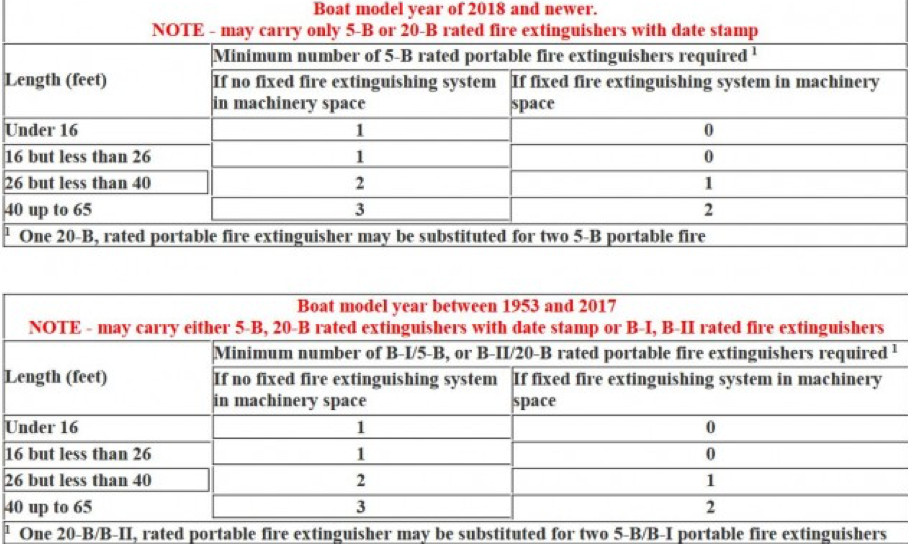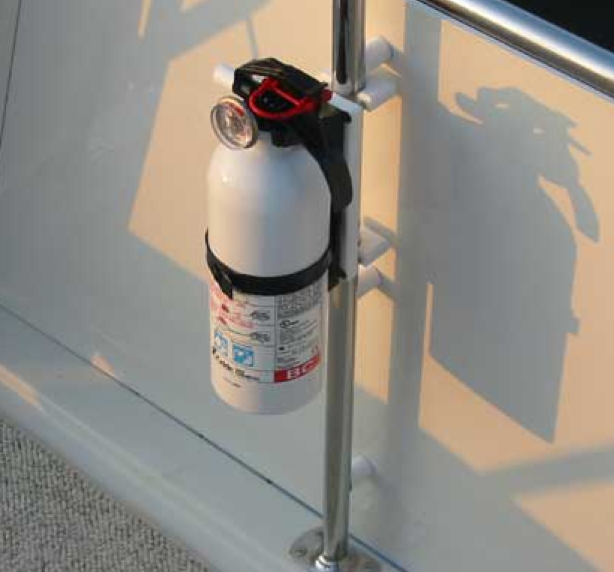New USCG Fire Extinguisher Requirements Coming in April

It may be cold and icy on the water but now's the time to pay attention to a new federal regulation for fire extinguishers on motorized recreational boats taking effect on April 20, 2022.
The big change is that fire extinguishers older than 12 years from the manufacture date are no longer considered good and serviceable and should be replaced with a newer fire extinguisher.
This includes both disposable (non-rechargeable) and rechargeable fire extinguishers. And while you are checking your fire extinguishers, make sure they are properly pressurized, labeled for Marine use “Marine Type U.S.C.G.” and are of the specific type required for your vessel length.
Common Questions About New Fire Extinguisher Regulations

Q. Where can I find the recently published regulations for fire protection for recreational vessels?
A. These regulations will be incorporated into 33 CFR 175, Sub-Chapter S in the near future.
Q. What is the effective date of this new regulation?
A. April 20, 2022.
Q. What is new?
A. If your fire extinguisher has a date of manufacture stamped on the bottle (example: “05” means 2005), and it is older than 12 years, the extinguisher is considered expired and must be removed from service. Look for wording on the bottle stating “This product must be removed from service within 12 years after date of manufacturing.”
Q. Are there any changes for when fire extinguishers are required or the number of extinguishers required?
A. No. If your boat was required to carry a fire extinguisher, it is still required to do so under this new regulation. There is also no change to the quantity required.
Fire Extinguisher Requirements


Q. Which recreational boats are required to carry fire extinguishers?
A. All recreational boats with: 1. Permanently installed fuel tank(s), or 2. Spaces that are capable of trapping fumes, such as a closed compartment under thwarts and seats wherein portable fuel tanks may be stored.
b. Double bottom not sealed to the hull or that is not completely filled with flotation material.
c. Closed living space.
d. Closed stowage compartment in which combustible or flammable materials is stowed.
Q. Are there any motorized recreational boats exempt from having to carry a fire extinguisher?
A. Yes. If your boat is less than 26’ feet in length, uses an outboard engine, fuel is in a portable fuel tank, and there are no areas within the boat where fuel vapors can be trapped, the boat is not required to have a fire extinguisher.
How Many do I Need?

Q. How can I tell if a fire extinguisher is approved for my boat?
A. The label on the bottle will state “Marine Type – USCG Approved.” Underwriters Labs approves fire extinguishers on behalf of the USCG.
Q. How many USCG-approved fire extinguishers do I need to have readily accessible onboard my boat?
A. You are required to carry a quantity of 5-B or 20-B UL-rated USCG-approved extinguishers as required in the chart shown here for recreational boats 65 feet in length and less.
For recreational vessels greater than 65 feet, see FAQ #16. If your vessel is older than model year 2017, you may carry a B-I or B-II rated fire extinguisher instead, but you must replace them with a 5-B or 20-B when they are no longer good and serviceable.
All recreational vessels of model year 2018 and newer must carry 5-B or 20-B rated fire extinguishers that are date stamped. Vessels older than model year 2018 may carry either 5-B or 20-B rated fire extinguishers that are less the 12 years old or B-I or B-II rated fire extinguishers that are in good and serviceable condition.
Fire Extinguisher Maintenance

Q. How must my fire extinguishers be maintained?
A. Fire extinguishers must: 1. Be on board and readily accessible; 2. Be of an approved type; 3. Not be expired or appear to have been previously used; and 4. Be maintained in good and serviceable working condition, meaning: (i) If the extinguisher has a pressure gauge reading or indicator it must be in the operable range or position; (ii) The lock pin is firmly in place; (iii) The discharge nozzle is clean and free of obstruction; and (iv) The extinguisher does not show visible signs of significant corrosion or damage.
Q. The gauge on my unused fire extinguisher is in the red. What should I do?
A. If a fire extinguisher pressure gauge shows that the charge is in the red zone, a disposable fire extinguisher must be discarded and replaced. A rechargeable extinguisher must be serviced and tagged.
Q. What is the difference between a rechargeable and non-rechargeable portable fire extinguisher?
A. A non-rechargeable fire extinguisher, also referred to as a disposable fire extinguisher, is intended for one-time use only. A rechargeable fire extinguisher is recharged once used. A rechargeable portable fire extinguisher requires regular maintenance and servicing; a disposable does not. A disposable must be removed from service after 12 years from date of manufacturing stamped on the bottle.
When a Fire Extinguisher is Too Old?
Q. How do I tell if I need to replace my disposable (non-rechargeable) fire extinguisher if it is too old?
A. Disposable (non-rechargeable) dry chemical fire extinguishers, must be removed 12 years after their date of manufacture. These extinguishers generally have their year of manufacturing stamped on the bottom or have its year marked next to its UL label.
Q. Where do I find the date of manufacturing on a rechargeable fire extinguisher?
A: The date of manufacturing on a rechargeable fire extinguisher is printed on the label of the bottle. The first National Fire Protection Association (NFPA) certified inspection is due one year from the date of manufacturing and the bottle tag must indicate this inspection. A rechargeable U.S. Coast Guard Office of Auxiliary and Recreational Boating Safety 4 does not need to be removed from service after 12 years, but it instead must be maintained annually by a technician.
Need for a Bracket?
Q. I bought a fire extinguisher and in the box is a plastic mounting bracket. The label on the fire extinguisher bottle says it is valid only with bracket. Do I need to mount the fire extinguisher using this bracket?
A. It is highly recommended to mount the fire extinguisher, but it is not a requirement to mount the fire extinguisher. All portable extinguishers must be readily accessible.
Q. What if my recreational vessel is longer than 65’ (19.81 m)?
A. A recreational vessel more than 65’ (19.81 m) long must carry at least the minimum number of portable fire extinguishers specified for its tonnage as set forth in table 4 to § 175.320(b)(1).